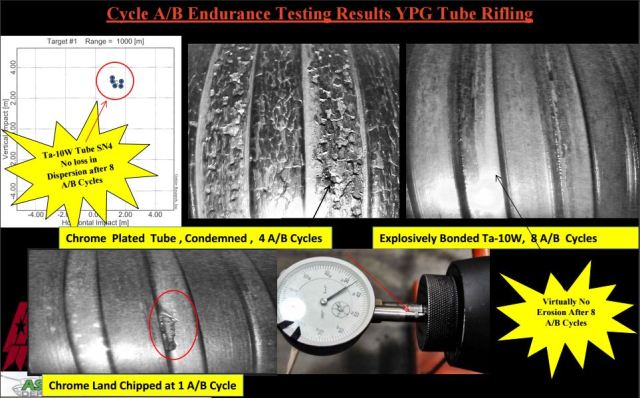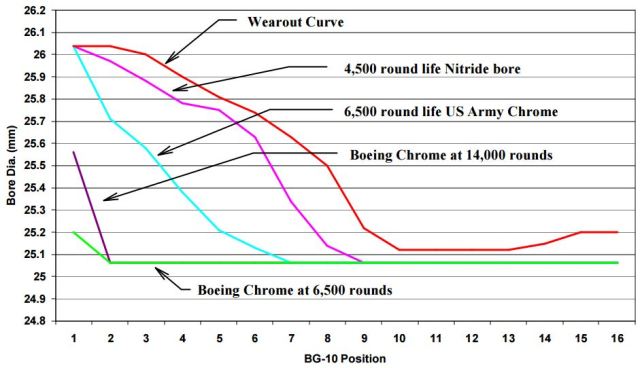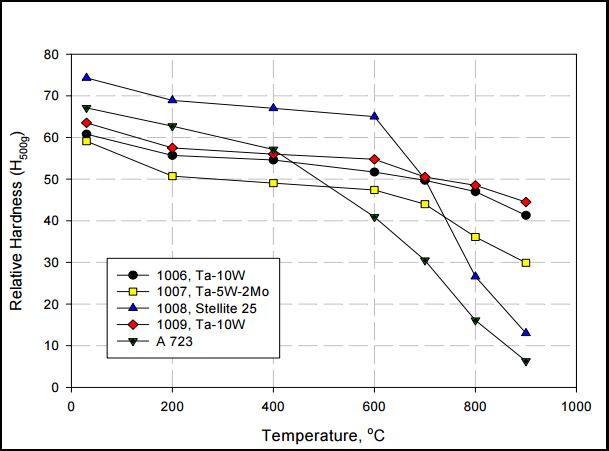So the recent (recent as the time of this posting anyways) USMC Request for Information (RFI) got me dusting off old references to extreme high round count experimental barrel technology. This topic often has people asking the question, “what is the best for my rifle? Stainless? Chrome lined? Nitrided or Melonite?” The good news is that the US Government has been asking that very question for decades now, and actually has some research into the subject. Don’t expect a clear answer though, because “best” is often defined by multiple competing factors that are different for different consumers.
What follows are excerpts lovingly transcribed from the scan (pdf warning):http://www.dtic.mil/dtic/tr/fulltext/u2/822736.pdf
The procedure as developed by Springfield Amory for design and fabrication of a stellite-lined, chromium-plated barrel for the 5.56mm machine gun is described. Results of erosion tests of the stellite-lined barrels, standard barrels, and two other types of barrels show that the stellite-lined barrels are superior in erosion resistance. One of the stellite-lined barrels was fired 43,995 rounds prior to rejection. A maximum of 12,476 rounds was fire from one of the standard barrels prior to rejection. The two other types of barrels – standard barrel with a nitride bore and a barrel of two-piece construction – were fired 29,874 and 990 rounds, respectively before rejection.The two-piece barrel has an 18-inch forward section made from Cr-Mo-V steel and the rear section, including the chamber, is made entirely from stellite. All barrels were rejected on the bases of the projectile instability criterion – 15 degrees yaw of 20 percent of the projectiles fired. All barrels were fired at an average rate of 200 shots per minute.
Of the four types of machine gun barrels tested, the Springfield Armory 3-piece, stellite-lined barrel with chromium-plated bore gave superior erosion resistance. Two barrels of this configuration, designated Proto 1 and Proto 2, were rejected after 33,433 and 43,994 rounds respectively, were fired. Rejection was based on projectile instability criterion of 15 degrees yaw in 20 percent of the shots fired during a test cycle – in this instance, 40 shots out of 200 shots fired.
The two standard barrels with nitride bores were procured from Manufacturer X and were second in erosion resistance in that these barrels were fired 29, 874 and 26, 774 rounds before rejection. These barrels were designated N1 and N2, respectively.
The maximum erosion life of the standard unplated barrels in this test was 12, 476 rounds for Barrel S11. Barrels 2, 3, 588, and 590B were rejected at 2509, 5088, 7116, and 4209 rounds, respectively.
The standard unplated barrels and the standard barrels with nitride bores were made from 4150 resulphurized steel.
The barrels designated N1 and N2 had bores which were nitride by a process devised by Manufacturer X. These barrels were injected into the test after the test had started and were fired 29,874 and 26,774 rounds prior to rejection. These barrels were rejected on the baseis of the projectile stability criterion. The barrels had velocity losses of 30 and 75 feet per second, respectively.
Barrels Proto 1 and Proto 2 were designed and fabricated by Springfield Armory. These barrels were of the 3-piece construction design. The three pieces, or components, are the retainer, the stellite liner, and the tube. The tube has a chromium-plated bore. Drawings of these components are included in Appendix D. These barrels were rejected after 33,433 and 43,994 rounds, respectively, were fired. Velocity losses of 92 and 107 feet per second were recorded for these barrels. Rejection of these barrels was based on projectile instability.
This study suffers from the “small sample size” problem, but I do believe enough information was gathered to support the obvious conclusion that the study came to, both chrome lined bores and nitriding massively increase the usable life of machine gun barrels.
What this study doesn’t do is determine which is “better” as there are only two chromed bore (with stellite chambers) and two nitrided barrels to compare. We don’t have a “chrome bore, chrome chamber” barrel to compare with the nitrided barrels. However, from these studies we can confirm one thing, stellite liners are better than nitride, and nitride is going to be much better than bare ordnance steel (2 to 6 times better).
Here is another presentation which looks at machine gun barrel life using different liner materials (pdf warning): http://www.dtic.mil/ndia/2016/armament/18355_Armstrong.pdf and one that looks at a 25mm barrel (pdf warning): http://www.asetsdefense.org/documents/workshops/sustainablesurfaceengineering2011/46-campo_asetsdefense%202011%20workshopcampo%20eb.pdf

This is clearly a contractor slide on a 25mm Bushmaster barrel, as they are way too excited about Tantalum Tungsten alloy liners…. Also, we don’t know whether the chrome lined used was “Army Standard” or some other standard
So…what does this really mean to you? Not much unless you are into AR-15s. If you are, then either chrome lining or nitriding is going to be worth the additional cost over a bare steel barrel (nothing earth shattering there). I think that nitride options are more affordable on the market, although I don’t have good data on a nitrided 4140 steel barrel versus a chrome lined 4150 steel barrel. And honestly, the quality of chrome lining is going to vary between vendors, a lot.

This is also a contractor slide about a Bushmaster barrel. We don’t know what the Nitride solution was, but we do know that Boeing is really proud of their “Boeing Chrome” http://www.dtic.mil/ndia/2002/gun/waterfield.pdf
Now an AR-15 is not a machine gun, it was never designed to fire 200 rounds a minute for hours on end, so it is possible to get many thousands of rounds of service life from a bare steel barrel on an AR-15, because the number one killer of barrels isn’t round count, it is heat load. Here is good background reading on temperature: http://weaponsman.com/?p=23706 and http://weaponsman.com/?p=23824 . What the late great Hognose didn’t go into very much there was the chemistry behind the heat problem. In short, the steel starts taking in some of the carbon and nitrogen compounds produced by the cartridge, which makes that steel very brittle, which then is easier to wear away. Chemically inert treatments like stellite, chrome, or nitriding, massively reduce the ability of the underlying steel chemistry to change as it heats up, keeping the steel in place much longer. That’s the simplest explanation I can come up with, I don’t want to turn this post into a treatise chemistry and metallurgy.

Ta-10W (Tantalum Tungsten alloy) Ta-5W-2Mo (Tantalum Tungsten Molybdenum alloy) This chart clearly shows how heat makes things soft.
So, if you manage your barrel heat, you can shoot a lot longer than if you heat the barrel up a lot by firing rapidly. One varmint hunter I know found that he could triple the lifespan of his 22-250 rifles by simply taking two 22-250s with him when he went out, and alternating between shots so that neither rifle was shot more than once per ten minutes. Keeping the round count to six shots per hour per rifle gave him a much longer useful barrel life when popping prairie poodles on the plains. That is a much more affordable solution than some exotic ceramic lined barrel: http://www.nttc.edu/sbipp/technologyportfolios/portfolios/LCRATS-Vehicle/Archive/NAVY2001-002.pdf and http://ciar.org/ttk/mbt/papers/isb2007/paper.x.isb2007.IB06.5_point_56mm_ceramic_gun_barrel_thermal_analyses_with_cycled_ammunition.huang_conroy_carter.2007.pdf
So, now you still don’t know which is best, and given the variability between vendors it is a solid bet that a good Nitride finish is going to beat a bad Chrome job, and a good Chrome job is going to last longer than a bad Nitride finish. It will be easier for a barrel maker to make a highly accurate barrel with a Nitride finish since the barrel dimensions don’t change during the Nitriding process, but chromed lined barrels can be made very accurate as well (for example by Criterion, the “other side” of Krieger).
Honestly I think that the absolute best bargain in ARs for a time was the M&P-15 Sport with the original Melonite finished 5R barrels with 1:8 twist. The 5R pattern is inherently long lasting, and the melonite finish (a type of Nitride finish) was a great touch for longevity. It was a pity when S&W went to using a standard rifling profile 6 land/groove with “Armormite” finish (another type of Nitriding) in my opinion. They are still a pretty good bargain even with the 1:9 twist standard rifling barrel, and if you shoot a lot of 62gr or 69gr ammo should give you exceptional accuracy.
So right now…you can get a Nitrided barrel cheaper than a Chrome lined barrel in the AR-15 world. And I think that barrels are essentially a wear item, so even if a chrome lined barrel got 10% more life, that doesn’t matter if it costs even 11% more. You are money ahead buying the best you can for the lowest price per shot. And since it is easier to make an accurate Nitride barrel, that would get my recommendation as “best” at least in terms of money spent. But don’t get me wrong, I’m a fan of purchasing chrome lined Criterion barrels when they are on sale too.
UPDATE: MrGunsandgear did a rapid fire test of equivalent chrome lined and melonite barrels, and it looks like from his admittedly small test that melonite is better for preserving accuracy while chrome is better for preserving rifle function.
This is post mag dump accuracy test, which is part 3 of a 4 part series if you are interested.
UPDATE 2: The research conducted by Picatinny arsenal into cobalt steels for machine gun barrels has at least been adopted by FN, which now offers a cobalt steel barrel for the M2 machine gun. The cobalt steel barrel is listed as being good for 18,000 rounds, the normal hard chrome lined barrel is listed with a 10,000 round life. PDF warning for the report on cobalt steel barrels: http://www.arl.army.mil/arlreports/2014/ARL-RP-0491.pdf
Additionally the DOD is looking towards powder metal manufacturing and bi-metal solutions to extend small arms barrel life, so evidently the cobalt steel solution wasn’t cost effective enough for extending the round count at the individual weapon system level. https://patriotswithguns.com/articles/us-army-wants-powder-metal-gun-barrels/ This is very interesting to me as it seems like it will be very hard to get the cost per unit down below that of a cold hammer forged then chromed or nitride treated ordnance steel barrel, so unless there is some additional weight savings it will likely go nowhere (remember weapon systems tend to start out light and get heavier over time, look at the M16 evolution from M16 to M16A4, as well as the M4 to M4A1).

I have been researching this as well. I have a friend who puts stellite hardfacing on barrels all day long. They no longer use liners. It is a spray on type thing. Kennametal sells the equipment to do it. All the Saws, 50 cals etc now have this lining. Here’s the kicker, barrel cost would be north of a grand. I’m tempted to ask General Dynamics what they would charge me for something like 100 barrels if they would even do it. I believe it would mean a lifetime barrel in anything semi auto without Magnum load pressure.
LikeLike
If the US military is buying stellite lined barrels, that’s news to me. FN, the contarctor for the M249, M240 and M2 still lists “hard chrome” as the only barrel liner option for those, although the M2 does offer a “heat resistant alloy” which seems to be a cobalt steel that came out of the research that Picatinny Arsenal did a few years back. Then again, the service life for an M2 hard chromed barrel is 10,000 rounds, and the heat resistant alloy is 18,000 rounds. Does the 80% increase in barrel life justify whatever cost difference? I don’t know.
LikeLike
Don’t forget that while the working temperature of Hard Chrome is higher than bare 4150 steel or nitrided 4150 steel, nitriding is a chemical bonding and not a plating process, the 4150 expands and contracts at different rates than the Chrome Lining in the bore of the barrel.
This causes POI shifts as the barrels heat up which is another issue and in some cases results in substantial permanent accuracy loss even if you haven’t exeeded it’s maximum working temperature because of the stresses introduced in expansion and contraction. However it’s failure is typically more gradual then Nitride and the Mr. Guns Gear test showed just that.
The Hard Chrome lined barrel and the Nitrided barrel were both heated up quite a bit and while it’s unclear which one achieved higher temperatures, the Hard Chrome barrel suffered substantial permanent accuracy losses due to the heating while the nitrided barrel did not for the very reason that the two metals expand and contract at different rates in the Hard Chromed barrel. I’ll bet the Hard Chrome barrel has fire racking down the bore from the heat cycle.
So as long as neither barrel is pushed passed it’s thermal limits, Nitrided barrels typically hold their accuracy better. However Hard Chrome has slightly higher limits which is more suitable for sustained full auto and is why it is still used in machine guns.
Nitriding has also come quite far since that original comparison was done. It seems modern QPQ barrels are exceedingly durable, more so than what was avialable in the 1960’s when the above barrel testing was originally performed during the development of the AR.
LikeLike
If pure performance were the requirement for machine gun barrels they’d all be stellite lined high speed steel or cobalt steel in manufacture. Hard chrome is used because it hits the right performance level without excessive cost. Nitriding is more economical since there are fewer machining steps involved, but you are really limited as to the maximum thickness of the nitride layer which is something that chrome plating can easily overcome. I don’t really care, I shoot both barrels made with both technologies and am happy with both.
I still remember the TACOM notice to finally remove ALL of the unlined 50 caliber M2 barrels from the inventory, because someone finally realized that they needed to go and be replaced with something better than a bare steel bore. But, at some point the DOD did purchase a bunch of bare steel 50 cal barrels for machine gun use.
LikeLike